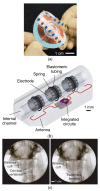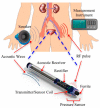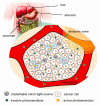Wireless Power Transfer Techniques for Implantable Medical Devices: A Review
- PMID: 32575663
- PMCID: PMC7349694
- DOI: 10.3390/s20123487
Wireless Power Transfer Techniques for Implantable Medical Devices: A Review
Abstract
Wireless power transfer (WPT) systems have become increasingly suitable solutions for the electrical powering of advanced multifunctional micro-electronic devices such as those found in current biomedical implants. The design and implementation of high power transfer efficiency WPT systems are, however, challenging. The size of the WPT system, the separation distance between the outside environment and location of the implanted medical device inside the body, the operating frequency and tissue safety due to power dissipation are key parameters to consider in the design of WPT systems. This article provides a systematic review of the wide range of WPT systems that have been investigated over the last two decades to improve overall system performance. The various strategies implemented to transfer wireless power in implantable medical devices (IMDs) were reviewed, which includes capacitive coupling, inductive coupling, magnetic resonance coupling and, more recently, acoustic and optical powering methods. The strengths and limitations of all these techniques are benchmarked against each other and particular emphasis is placed on comparing the implanted receiver size, the WPT distance, power transfer efficiency and tissue safety presented by the resulting systems. Necessary improvements and trends of each WPT techniques are also indicated per specific IMD.
Keywords: acoustic coupling; capacitive coupling; electromagnetic; implantable medical device; optical power transfer; tissue safety; wireless power transfer.
Conflict of interest statement
The authors declare no conflict of interest.
Figures




















































References
-
- Costanzo A., Dionigi M., Masotti D., Mongiardo M., Monti G., Tarricone L., Sorrentino R. Electromagnetic Energy Harvesting and Wireless Power Transmission: A Unified Approach. Proc. IEEE. 2014;102:1692–1711. doi: 10.1109/JPROC.2014.2355261. - DOI
-
- Garnica J., Chinga R.A., Lin J. Wireless Power Transmission: From Far Field to Near Field. Proc. IEEE. 2013;101:1321–1331. doi: 10.1109/JPROC.2013.2251411. - DOI
-
- Wang G., Liu W., Sivaprakasam M., Kendir G.A. Design and analysis of an adaptive transcutaneous power telemetry for biomedical implants. IEEE Trans. Circuits Syst. Regul. Pap. 2005;52:2109–2117. doi: 10.1109/TCSI.2005.852923. - DOI
-
- Sauer C., Stanacevic M., Cauwenberghs G., Thakor N.V. Power harvesting and telemetry in CMOS for implanted devices. IEEE Trans. Circuits Syst. Regul. Pap. 2005;52:2605–2613. doi: 10.1109/TCSI.2005.858183. - DOI
-
- Inanlou F., Ghovanloo M. Wideband Near-Field Data Transmission Using Pulse Harmonic Modulation. IEEE Trans. Circuits Syst. I Regul. Pap. 2010;58:186–195. doi: 10.1109/TCSI.2010.2055351. - DOI
Publication types
MeSH terms
Grants and funding
LinkOut - more resources
Full Text Sources
Other Literature Sources

